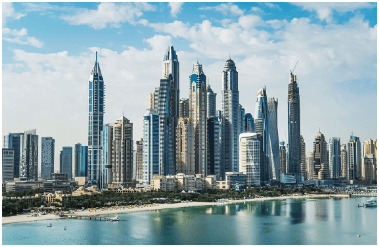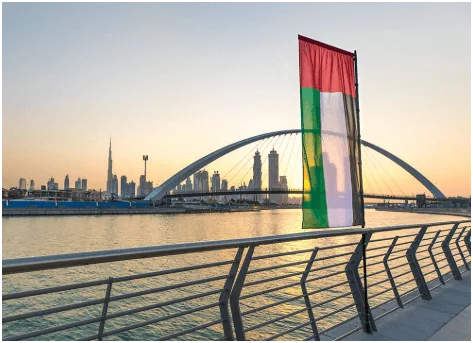Dubai real estate market is undergoing a significant transformation, with an increasing emphasis on holistic living through the development of mixed-use projects.
These developments integrate residential, commercial, and recreational spaces, reflecting a growing trend toward sustainability, convenience, and community-centered lifestyles. As Dubai continues to evolve as a global hub, the focus on creating well-rounded living environments aligns with the emirate’s strategic vision for future growth and enhanced quality of life.
Mixed-use developments are designed to foster a lifestyle where residents can access essential amenities without long commutes, reducing reliance on cars and promoting walkability. By incorporating green spaces, retail outlets, restaurants, fitness centers, and entertainment venues into residential areas, these developments cater to the diverse needs of modern urban dwellers. With this approach, the boundary between work, leisure, and home life becomes more fluid, creating communities that offer residents everything they need within a short distance. The goal is not only to enhance convenience but also to foster stronger social bonds, as residents are encouraged to engage in communal activities within shared spaces.
Dubai’s urban planners and developers are increasingly prioritizing sustainability in these projects. Energy-efficient designs, renewable energy systems, and environmentally friendly materials are becoming standard components of new developments. Many projects also emphasize green landscaping and water-saving technologies, contributing to Dubai’s long-term environmental goals. Initiatives promoting the use of bicycles and electric vehicles are also being incorporated into the infrastructure to reduce the carbon footprint and support the emirate’s ambition of becoming one of the world’s most sustainable cities.
A key example of this trend is the emergence of communities that blend residential units with office spaces, co-working hubs, and retail outlets. Developments like Dubai Hills Estate, City Walk, and Bluewaters Island exemplify the concept of live-work-play environments, offering residents a dynamic blend of urban amenities and tranquil living spaces. These communities feature jogging tracks, parks, cycling paths, and sports facilities, encouraging an active and healthy lifestyle. Such developments cater not only to families but also to young professionals and entrepreneurs who value proximity to their workplaces and recreational venues.
Social infrastructure is another essential element of these projects, with many developments including schools, healthcare facilities, and community centers. This integrated approach reduces the need for residents to travel far for essential services, making life more convenient and reducing urban congestion. As Dubai’s population grows, the demand for such mixed-use communities is expected to rise, driven by a desire for more balanced lifestyles. Developers are also taking into account the cultural diversity of residents, creating spaces that celebrate inclusivity and encourage social interaction among people from different backgrounds.
The rise of holistic developments reflects a shift in consumer preferences, with residents increasingly valuing experiences over material possessions. As people become more conscious of their physical and mental well-being, there is a growing preference for environments that support a balanced lifestyle. Developers are responding to this demand by offering wellness-oriented features such as meditation gardens, yoga studios, and spas within residential complexes. These features cater to the rising awareness of mental health and well-being, creating spaces that promote relaxation and rejuvenation amid urban living.
Technology also plays a crucial role in these developments, with smart home systems, app-based community management, and digital services becoming more common. Residents can access a range of services through mobile apps, from booking amenities and scheduling maintenance to participating in community events. This integration of technology not only enhances convenience but also promotes security, with smart surveillance systems ensuring a safe living environment. Additionally, many developments now offer co-living and co-working spaces to accommodate evolving lifestyles and foster collaboration within communities.
Another aspect driving the shift toward mixed-use developments is the increased focus on creating destination hubs that attract both residents and tourists. Iconic projects like Dubai Creek Harbour and Jumeirah Beach Residences exemplify this approach, combining luxury living with entertainment options, waterfront promenades, and cultural attractions. These developments serve as lifestyle destinations, attracting visitors from across the globe and contributing to Dubai’s tourism and retail sectors. The blending of residential and tourism components adds vibrancy to the community, enriching the overall experience for residents and visitors alike.
The COVID-19 pandemic has also influenced the design of real estate projects, with developers placing greater emphasis on flexibility and adaptability. The need for remote work and learning spaces has prompted the inclusion of home offices and study areas within residential units. Outdoor spaces have become more valuable, with terraces, balconies, and gardens gaining importance in providing residents with a connection to nature. This shift reflects a deeper understanding of how people’s living needs are evolving and highlights the importance of adaptable spaces that can meet future demands.
The Dubai government’s proactive policies have played a key role in supporting this trend. Initiatives such as long-term residency visas, investment incentives, and property ownership reforms have attracted investors and residents to Dubai’s real estate market. Additionally, the government’s focus on infrastructure development, including the expansion of public transport networks, has made mixed-use communities more accessible and desirable. These efforts align with Dubai’s broader vision of creating a smart, sustainable, and resilient city that offers a high quality of life for its residents.
As Dubai continues to grow, the shift toward mixed-use developments is expected to become even more prominent, with future projects likely to place an even greater emphasis on sustainability, well-being, and community engagement. Developers are increasingly adopting a long-term perspective, recognizing that creating holistic environments is essential for building resilient communities that can adapt to changing needs. With a focus on enhancing liveability and fostering social connections, these developments represent the future of urban living in Dubai.
In conclusion, Dubai’s real estate market is embracing a new era of mixed-use developments that offer more than just places to live. These projects reflect a commitment to creating sustainable, community-focused environments that promote well-being, convenience, and social interaction. As residents seek more balanced lifestyles and the city continues to evolve, mixed-use communities are set to become a defining feature of Dubai’s urban landscape. By integrating residential, commercial, and recreational spaces, these developments align with the emirate’s vision of creating vibrant, inclusive, and future-ready communities, ensuring that Dubai remains at the forefront of innovative urban living.
Stay Connected: ”Your Source for the Latest News Updates”



